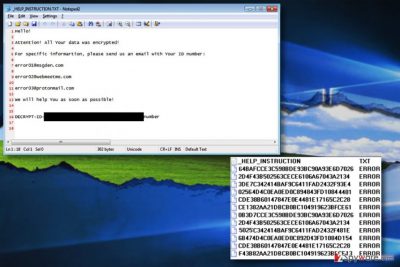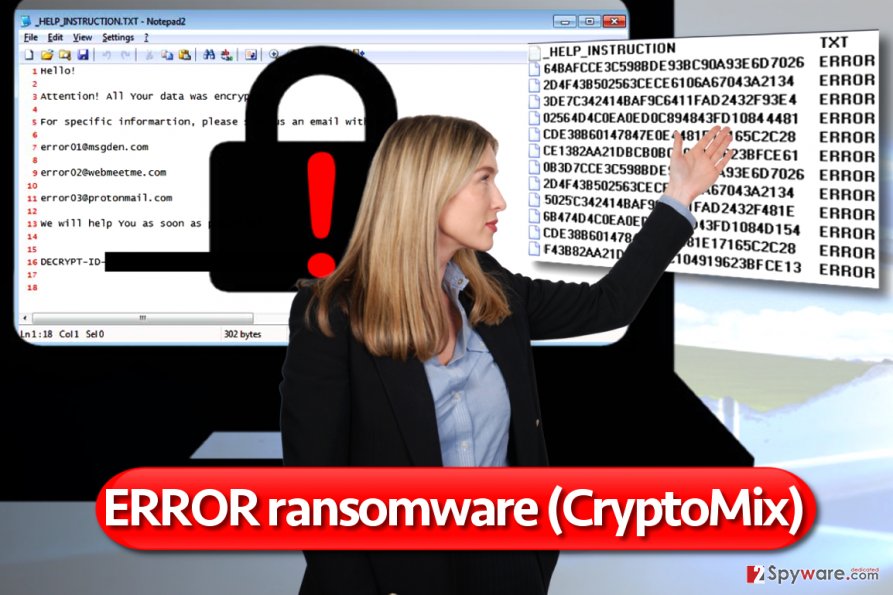ERROR ransomware / virus (Easy Removal Guide) - Decryption Methods Included
ERROR virus Removal Guide
What is ERROR ransomware virus?
Error ransomware comes to corrupt your files and demand a ransom

Error virus is a typical ransomware that comes from CryptoMix (Revenge) crypto-ransomware family[1]. As its name suggests, the virus appends .ERROR extension to files after encrypting them and changing their names. Earlier versions of the virus used .CK, .CNC, .OGONIA, .ZERO, .ZAYKA and .MOLE file extensions to mark the corrupted files. Just like previous variants, the virus leaves _HELP_INSTRUCTION.txt file with instructions for the ransom payment.
Ransomware uses eleven RSA-1024 keys to corrupt the AES key that is used to encode[2] victim's data. This gives the virus a possibility to work in offline mode on the compromised system.
The style of the virus hasn’t changed as well as the contents of the ransom note. It provides three email addresses for the victim so that one could contact the attackers immediately:
Hello!
Attention! All your data was encrypted!
For specific information, please send us an email with your ID number:error01@msgden.com
error02@webmeetme.com
errorout@protonmail.comWe will help you as soon as possible!
[victim’s identification number (ID)]
We do not encourage you to write to any of the provided emails because the cyber criminals will simply reply with a ransom demand. They might ask you to pay a sum worth $500-$2000 in Bitcoins (cryptocurrency). Such payment method helps criminals cash out the collected ransoms without being identified.
While it is not recommended to pay a ransom to ransomware developers, we also have to point out that it is hardly possible to restore files without having the decryption key (hidden in cyber criminals’ servers). Sadly, only a data backup can efficiently help you to restore your files.
If you haven’t created it in the past, then it will be very hard or nearly impossible to restore your .error file extension data back to normal. You can use one of the provided methods (find them below the article) to recover some of the corrupted records.
Before you attempt to remove Error ransomware virus, we strongly suggest restarting your computer in a safe mode with networking and updating your security software first. This way, it will recognize this new Cryptomix version and delete it without any problems.
You can find in-detail CryptoMix Error ransomware removal instructions right below the article. In case you do not have a security software to use at the moment, consider installing a program recommended by our team.

Distribution of the disastrous crypto-ransomware virus
CryptoMix (Revenge) ransomware variants were noticed spreading via malicious spam[3], although cyber security researchers also revealed another distribution channel used to infect computers with this virus – RIG exploit kit.
It appears that scammers are infecting websites and inserting a malicious JavaScript code into them. If the victim happens to enter such website, the exploit kit scans victim’s computer for vulnerabilities and uses them to execute the ransomware on the system.
To prevent this virus’ attack, you must have an up-to-date anti-malware software as well as a copy of your files stored on an external data storage device (USB or portable hard drive). We must add that it is essential to enable automatic software updates so that you wouldn’t have to update each program manually and always have the latest and the most secure software versions on your system.
Remove Error ransomware in a few minutes
Remove Error virus as soon as you can and make sure you use a trustworthy malware removal tool to complete this task properly. We do not recommend you to rely on vague system cleaners that can hardly identify malicious computer programs. To choose a security product that meets your expectations, read software reviews provided on our site.
We must point out that Error ransomware removal is not an easy task and it cannot and shouldn’t be completed manually. If you are not an IT expert, it is likely that your attempts to eliminate the virus will be unsuccessful. To erase the virus from the system professionally, rely on a security product that can really do its job.
Getting rid of ERROR virus. Follow these steps
Manual removal using Safe Mode
Delete the Error ransomware. Start by rebooting your computer in a Safe Mode with Networking. Follow the given instructions to complete the removal.
Important! →
Manual removal guide might be too complicated for regular computer users. It requires advanced IT knowledge to be performed correctly (if vital system files are removed or damaged, it might result in full Windows compromise), and it also might take hours to complete. Therefore, we highly advise using the automatic method provided above instead.
Step 1. Access Safe Mode with Networking
Manual malware removal should be best performed in the Safe Mode environment.
Windows 7 / Vista / XP
- Click Start > Shutdown > Restart > OK.
- When your computer becomes active, start pressing F8 button (if that does not work, try F2, F12, Del, etc. – it all depends on your motherboard model) multiple times until you see the Advanced Boot Options window.
- Select Safe Mode with Networking from the list.

Windows 10 / Windows 8
- Right-click on Start button and select Settings.

- Scroll down to pick Update & Security.

- On the left side of the window, pick Recovery.
- Now scroll down to find Advanced Startup section.
- Click Restart now.

- Select Troubleshoot.

- Go to Advanced options.

- Select Startup Settings.

- Press Restart.
- Now press 5 or click 5) Enable Safe Mode with Networking.

Step 2. Shut down suspicious processes
Windows Task Manager is a useful tool that shows all the processes running in the background. If malware is running a process, you need to shut it down:
- Press Ctrl + Shift + Esc on your keyboard to open Windows Task Manager.
- Click on More details.

- Scroll down to Background processes section, and look for anything suspicious.
- Right-click and select Open file location.

- Go back to the process, right-click and pick End Task.

- Delete the contents of the malicious folder.
Step 3. Check program Startup
- Press Ctrl + Shift + Esc on your keyboard to open Windows Task Manager.
- Go to Startup tab.
- Right-click on the suspicious program and pick Disable.

Step 4. Delete virus files
Malware-related files can be found in various places within your computer. Here are instructions that could help you find them:
- Type in Disk Cleanup in Windows search and press Enter.

- Select the drive you want to clean (C: is your main drive by default and is likely to be the one that has malicious files in).
- Scroll through the Files to delete list and select the following:
Temporary Internet Files
Downloads
Recycle Bin
Temporary files - Pick Clean up system files.

- You can also look for other malicious files hidden in the following folders (type these entries in Windows Search and press Enter):
%AppData%
%LocalAppData%
%ProgramData%
%WinDir%
After you are finished, reboot the PC in normal mode.
Remove ERROR using System Restore
-
Step 1: Reboot your computer to Safe Mode with Command Prompt
Windows 7 / Vista / XP- Click Start → Shutdown → Restart → OK.
- When your computer becomes active, start pressing F8 multiple times until you see the Advanced Boot Options window.
-
Select Command Prompt from the list

Windows 10 / Windows 8- Press the Power button at the Windows login screen. Now press and hold Shift, which is on your keyboard, and click Restart..
- Now select Troubleshoot → Advanced options → Startup Settings and finally press Restart.
-
Once your computer becomes active, select Enable Safe Mode with Command Prompt in Startup Settings window.

-
Step 2: Restore your system files and settings
-
Once the Command Prompt window shows up, enter cd restore and click Enter.

-
Now type rstrui.exe and press Enter again..

-
When a new window shows up, click Next and select your restore point that is prior the infiltration of ERROR. After doing that, click Next.


-
Now click Yes to start system restore.

-
Once the Command Prompt window shows up, enter cd restore and click Enter.
Bonus: Recover your data
Guide which is presented above is supposed to help you remove ERROR from your computer. To recover your encrypted files, we recommend using a detailed guide prepared by 2-spyware.com security experts.If your files are encrypted by ERROR, you can use several methods to restore them:
Restore data using Volume Shadow Copies
In some cases, victims successfully recover their files from Volume Shadow Copies that Windows creates automatically. However, ransomware often tries to corrupt these files. We strongly recommend trying ShadowExplorer to see if there are any VSS left on your system.
- Download Shadow Explorer (http://shadowexplorer.com/);
- Follow a Shadow Explorer Setup Wizard and install this application on your computer;
- Launch the program and go through the drop down menu on the top left corner to select the disk of your encrypted data. Check what folders are there;
- Right-click on the folder you want to restore and select “Export”. You can also select where you want it to be stored.
No .ERROR file extension recovery tools are available at the moment
Finally, you should always think about the protection of crypto-ransomwares. In order to protect your computer from ERROR and other ransomwares, use a reputable anti-spyware, such as FortectIntego, SpyHunter 5Combo Cleaner or Malwarebytes
How to prevent from getting ransomware
Stream videos without limitations, no matter where you are
There are multiple parties that could find out almost anything about you by checking your online activity. While this is highly unlikely, advertisers and tech companies are constantly tracking you online. The first step to privacy should be a secure browser that focuses on tracker reduction to a minimum.
Even if you employ a secure browser, you will not be able to access websites that are restricted due to local government laws or other reasons. In other words, you may not be able to stream Disney+ or US-based Netflix in some countries. To bypass these restrictions, you can employ a powerful Private Internet Access VPN, which provides dedicated servers for torrenting and streaming, not slowing you down in the process.
Data backups are important – recover your lost files
Ransomware is one of the biggest threats to personal data. Once it is executed on a machine, it launches a sophisticated encryption algorithm that locks all your files, although it does not destroy them. The most common misconception is that anti-malware software can return files to their previous states. This is not true, however, and data remains locked after the malicious payload is deleted.
While regular data backups are the only secure method to recover your files after a ransomware attack, tools such as Data Recovery Pro can also be effective and restore at least some of your lost data.
- ^ Douglas Bonderud. Rapid Revision: New CryptoMix Strains Picking Up Speed. Security Intelligence. Analysis & Insight on Information Security.
- ^ Cassius Puodzius. How encryption molded crypto-ransomware. WeLiveSecurity. The Latest News, Research, Cyber Threats and Malware Discoveries.
- ^ CryptoMix virus’ authors release three new versions – Zayka, Noob, and CK ransomware. VirusActivity. Cyber Security and Malware News.





















